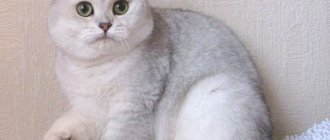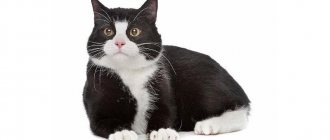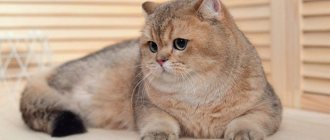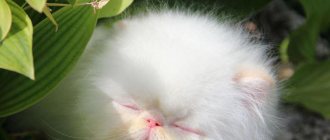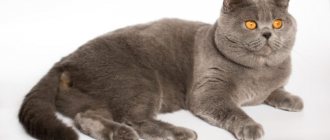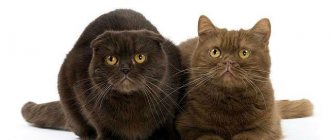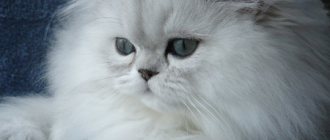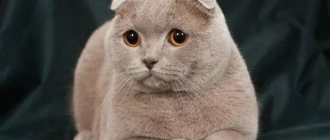The Golden Chinchilla is a cat of an original and rare color, which is most common among the British, Scots and Persians. It was bred artificially by crossing representatives of different breeds.
These animals are extremely popular and invariably win “feline beauty” competitions. But in order to find a purebred pure golden chinchilla kitten, you need to learn about its characteristics and standard requirements.
History of the unique color
The first golden chinchilla kittens were born in a litter of silver chinchilla Persian cats. Breeders were interested in the unusual coloring, but were unable to find the gene responsible for it.
This is interesting. Silver chinchillas have a white coat, and the darkened ends of the hair create the effect of a thrown veil.
Experts decided that the golden pigment appears as a result of the interaction of a whole group of genes. And then the breeders began targeted selection to consolidate the desired trait in the genotype of the animals.
British golden chinchilla cats were bred in the UK. They were created by crossing a Golden Persian and a Smoky Briton. As a result of systematic work, a cat named Silver Lambkin appeared in 1889, who was recognized as the ancestor of this variety.
A little later, Scottish cats began to be crossed with Golden Persians and the British. Animals of this color looked very impressive.
This is interesting. Golden chinchilla cats are often called royal or royal.
Genetics of color
A polygenic complex is responsible for the golden chinchilla color, providing a warm shade of the undercoat and a lightened background color:
- melanin inhibitor – absorbs hair pigment, starting from the hair root;
- agouti and tabby (tabby) - forms a pattern;
- erizer – gene eraser, gives the undercoat a warm shade.
The golden chinchilla color includes several varieties depending on the color of the hair tips:
- black;
- chocolate;
- lilac;
- faun (fawn);
- cinnamon (cinnamon);
- blue.
The golden color is a recessive trait in relation to the silver color. Kittens of this color can be obtained in the following cases:
- both manufacturers have a golden color;
- parents are silver chinchillas, but are carriers of the golden gene;
- one producer is golden, the second is silver, but his genotype contains genes for goldenness.
Mr. Cat recommends: description, characteristics, breed standard
Today, these beautiful animals Chinchilla britich gold are very popular and breeders often hear about the desire of buyers to purchase a “Scottish Golden Chinchilla kitten,” but this phrase is wrong.
These cats are indeed of the Scottish or British breed, and they can be either fold-eared or straight-eared, but the phrase Golden Chinchilla refers only to the color, which pets of some other varieties, for example, Persians, can also have. British cats received this color from their Persian ancestors more than half a century ago.
When considering the genetics of a rare color, it will be necessary to analyze several hypotheses of its appearance, since scientists do not have an exact answer, just as there is no genetic test to establish the color unambiguously.
For this, there is only a visual method that combines several features:
- The undercoat part of the coat has an apricot tint due to the fact that the basal parts of the guard hairs are colored in this tone.
- The upper parts of the guard hairs are black, half for tabby colors, one third for shaded colors and one eighth for tipped or ticked animals (this is chinchillas).
- The tip of the animal's tail, paw pads, nose, cornea, and lips have a shade of the base color.
Characteristics and color features
Regardless of the breed, chinchilla cats should have hair with a smooth color transition from soft pink to dark at the tips. The undercoat can be of different shades: from light peach to red. There should be no dull or grayish areas on the body.
The color is considered chinchilla if the dark tip occupies 1/8 of the length of the hair. If 1/3 is painted, the color is called shaded, if 1/2 is called golden tabby.
In chinchillas, the pigmentation of the iris is usually green or bluish-green. There is a dark brown or black edging on the eyelids, lips and nose. The lobe is colored pink, the paw pads are black or brown.
Information about the breed and color of the cat is indicated in the pedigree. Special designations are used for this.
Breed:
- BRI - British;
- PER – Persian;
- SFL – Scots Fold Shorthair;
- SFS – long-haired Scots Fold;
- SCS – Scots with erect ears, shorthair;
- SCL – long-haired, erect-eared Scotsman.
Color:
- y – golden;
- a – blue;
- b – chocolate;
- c – lilac;
- n – black;
- o– cinnamon;
- q – faun.
Picture code:
- 11 – shaded;
- 12 – chinchilla;
- 21 – linx (tabby pattern on the face and paws);
- 22 – marble;
- 23 – brindle;
- 24 – spotted;
- 25 – ticked (each hair has more than two dark zones);
- 33 – point (reminiscent of the Siamese color).
At the end they put numbers indicating eye color:
- 64 – green;
- 61 – blue;
- 62 – yellow.
For example, a Scottish fold short-haired chinchilla of golden color with black tips of hairs and green eyes would be written as follows: SFLny 12 64.
Golden Chinchilla Standards
For the first time, the golden chinchilla color was included in the standard of Persian cats. Now it is found in many breeds for which the silver chinchilla color is recognized.
Preference is given to cats with a uniform golden undercoat without a gray area at the roots. When the color first appeared, such animals were still used for breeding, but now they are increasingly not allowed to breed.
There is no single standard regulating the color of the golden chinchilla. Experts evaluate animals in accordance with documents approved for a specific breed by the World Cat Federation:
- British cats are stocky, massive and muscular. The head is round, with a wide skull and pronounced cheeks. The ears are small, set wide, and the tips are slightly rounded. The tail is thick and curves upward. The coat is raised, dense and short.
- Scottish - divided into fold-eared (Scottish fold) and straight-eared (straight). The first ones have small ears, the tips hanging forward. The limbs are short and thick. Straights have erect ears and can be small or medium in size. The limbs are slightly longer and lighter.
- Persian - distinguished by rectangular body lines. Legs are strong and short. The head is large, the forehead is sloping (other chinchillas have a rounded forehead).
Golden chinchillas have ears covered with dense and short fur. The eyes are very large and expressive.
Appearance
Each cat breed has characteristics specific to that species. In the case of chinchillas, experts still cannot determine the standard criteria to give accurate definitions of weight, height and other characteristics.
From a distance, the animal's fur appears to be a uniform golden tone, but this is deceiving. Each hair has a double color, at the root it is pure red, the tips are black. The color smoothly transitions into one another, which gives a slight shadedness, which is especially pronounced on the sides and on the back.
You can determine the golden color of a fur coat by the following parameters:
- the basal part of the guard hair and the undercoat are peach-colored;
- the middle part of the guard hair is black;
- upper part – shaded color;
- the tip of the hair is tipped;
- the tip of the tail is the base color.
The Scottish Golden Chinchilla has a medium-length, bouncy, plush-like coat.
Need to know. If the third part of the hair is black, the color is considered shaded, the eighth part is black - chinchilla.
Signs of a Scottish Golden Chinchilla:
- the head is round, small, with a protruding skull, pronounced chin, thick cheeks;
- forehead - with a small flat depression;
- ears – folded, tilted down and forward (Scottish fold) or straight, medium in size (Scottish Straight);
- nose – short, upturned, pale pink, with a dark outline;
- eyes – large, expressive, widely set, emerald in color, with dark edging;
- body – compact, with developed muscles, straight back, chest – raised;
- paws - the same size, rounded, with dark pads and hair between the toes;
- the tail is straight, short, thick, drooping, with a rounded tip.
British
British chinchillas are usually smaller. They ripen late - full formation of the exterior is completed by 3 years.
The wool has a soft and silky texture. There are 2 varieties: British shorthair and longhaired chinchillas. The latter have elongated fur, which is inherited from Persian cats.
The most common are golden chinchillas with green eyes, but there are cats with blue and yellowish irises.
Scottish
The Scottish chinchilla cat has the same color as the British one. She has a plush coat, a dense undercoat of a warm shade, dark lining of the eyelids, lips and nose, and brown paw pads.
The eyes are most often green, but can also be blue. These animals have soft, rounded body shapes, which provide developed muscles and thick hair.
Persian
Persian chinchillas are slightly smaller than their counterparts. They are harmoniously built, distinguished by fine bones and elegance, but at the same time strong and resilient. In the USA, larger cats are bred, which are very similar in size and build to standard Persians.
The coat of Persian golden chinchillas is long and dense. The fur shimmers beautifully in the light. The cat may have emerald or bluish eyes with a brown rim. The soft pink nose is small and neat.
Character and behavior of elite pets
Chinchillas are considered the aristocrats of the cat family. They are distinguished by noble manners, a sharp mind and excellent memory.
The characteristics of golden chinchilla cats are determined by the breed:
Each animal has individual character traits. Therefore, the habits and behavior of pets may differ slightly from the description given.
Character
British chinchilla cats are distinguished by aristocratic manners, calmness, and a good nervous system. Up to a year old, babies are very active and love to play. Adult pets are most often balanced and treat their owner as a friend. The British do not like to sit on their hands; they prefer to approach them themselves for a portion of affection.
Animals understand the situation very well and are able to manipulate the owner and family members. Plush beauties most often cannot stand strangers; there are known cases of hostility towards drunken visitors to the house. But by purchasing a British chinchilla cat, a person receives a devoted companion. The pet is attached to the house and can resort to tricks if the owner is forced to say goodbye to it. Sometimes they hide or pretend to be sick when strangers appear.
British Chinchillas get along well with other pets indoors. But the arrival of a new pet must be planned. It is necessary to separate the arriving baby from the old friend. Gradually allow animals to be together. If you do not provide for the behavior of pets, you can get sick and sick in cats.
British chinchillas are prone to depression. They buy toys and mazes for the animal. A mobile, active pet eats well and looks great.
The description of the breed and character of the British chinchilla shows: pets get along well with children. But you should not allow your child to squeeze and knead the baby immediately after coming into the house. The furry baby is given time to get used to the new home, food, smells and sounds.
Features of care and maintenance
Owners of golden chinchilla cats have to comb their luxurious coat at least 2 times a week to keep it tidy. During the molting period, the procedure is carried out daily.
Chinchillas have a two-layer coat. It must be combed in 2 stages: first along the hair growth, then against it. It is recommended to use a fine-toothed comb or a special glove.
Cats are bathed as needed, but not more than once every 3-4 months. Due to frequent washing, the coat becomes dry and brittle. Dry products are used as a replacement for regular shampoos.
Otherwise, care for golden chinchillas is standard:
The pet should have a separate place to rest, a variety of toys and a cat scratching post. Animals quickly learn to use the toilet, but the tray must be large and comfortable, since the golden chinchilla color is found in fairly large breeds.
For your information. Some cats like to walk on a leash or harness. However, most of them are satisfied with being in a confined space - a house or apartment.
How to choose a kitten and its cost
Kittens are ready to go from the age of two months. By this time, a good breeder will have trained the kittens to litter box and feed themselves. In addition, at two months of age it is already possible to determine the individual character of a kitten, so you can choose a specimen that is suitable in temperament.
Representatives of purebred Persian chinchillas cost from 10,000 rubles. Moreover, the pedigree of such a cat consists of show parents and is also intended for breeding. If the owner does not pursue such goals, it is possible to find a kitten for 500-1000 rubles.
Before purchasing, be sure to inspect the animal; a representative of the breed must have all the phenotypic and physiological characteristics of its species.
Feeding the animals
For feeding golden chinchillas, like other purebred cats, high-quality ready-made food with a protein content of at least 30-35% is suitable. They have a balanced composition and fully satisfy the needs of the animal’s body.
The following brands have proven themselves well:
- 1st Choice;
- Hills;
- Acana;
- Leonardo;
- Sanabelle Bosch;
- Pro Plan.
If the owner chooses a natural diet, then it is based on meat - turkey, chicken, veal. The meat needs to be frozen for 2-3 days. It is given raw, cut into pieces and doused with boiling water. These measures are necessary to destroy parasites and bacteria.
Cats do not refuse offal. Liver, lung, heart, tripe are suitable for feeding. They must be boiled for several hours.
Also included in the diet:
- rice and buckwheat porridges;
- boiled sea fish fillet (if you have problems with the genitourinary system, this product is excluded);
- boiled vegetables (zucchini, carrots, pumpkin, cauliflower);
- egg yolk (no more than 2 times a week);
- fermented milk products with low fat content (kefir, yogurt, cottage cheese, natural yogurt).
Pets are fed 2-3 times a day. Food from the human table is contraindicated for animals.
Important. The structure and appearance of the coat directly depend on the quality of nutrition. Errors in feeding lead to dull and brittle fur and prolonged molting.
Catering
What to feed Persian chinchillas
If your pet does not have individual diseases or other problems that require special nutrition, you can rely on the standard menu for this breed:
- Boiled beef/chicken/turkey fillet;
- Beef and chicken by-products;
- Protein foods (for example, boiled eggs);
- Lean sea fish (no more than 10% of the weekly diet);
- Vegetables or vitamin supplements recommended by a veterinarian;
You can switch your cat to premium dry food, the composition of which is tailored to this breed. In this case, make sure that your pet always has access to fresh drinking water.
Purebred Persian cats are picky eaters. But if the owner listens to the wishes of the pet, he will thank him with peaceful purrs for many years.
How much does a royal chinchilla cost?
Pure golden color is quite rare. More often you can see kittens having the so-called halftone. In the metrics that are issued at 1.5 months, they are often noted as golden chinchillas. But after molting, which takes place in 5-8 months, the color changes.
For people who have a kitten as a pet, these nuances do not matter. But for those who breed or plan to participate in exhibitions, color purity is very important.
To avoid misunderstandings, you should:
- carefully study the requirements for color and its features;
- read reviews about breeders offering such animals;
- meet the kittens’ parents and evaluate their compliance with the standard.
Due to the difficulty of obtaining a color, a kitten is quite expensive:
- British chinchillas: pet class - 25 thousand rubles, show class - about 50-70 thousand rubles;
- Scottish and Persian cats: pet class - 12-25 thousand rubles, show class - from 35 thousand rubles.
Purebred kittens can be purchased at a specialized nursery or from a reputable breeder who breeds animals of this particular color.
Important. Finding a rare pet from an ad on the Internet is almost impossible. Chinchillas are bred only through competent breeding work.
There is a common misconception that there is an independent breed of golden chinchilla cats. Because of this, confusion often arises. For example, people who count on an easy-going Briton end up with wayward Scots. Therefore, it is so important to first find out all the nuances, and only then get a pet.
Golden chinchilla cats are very rare, unusually beautiful and intelligent animals. These are real fluffy “suns”, a find for lovers of luxury and chic.
Price and reviews about representatives of the breed
The price of a golden chinchilla cat starts from 10,000 rubles if the kitten has a document. If the animal’s pedigree means it will become a show-class pet and confirms this with its exterior, I can ask for 25,000-40,000 rubles. Persians tend to be cheaper, while British and Scots are more expensive.
Reviews about golden chinchillas are as contradictory as the breeds that wear the royal color. The disagreements are mainly related to the nature of the animals. It must be in harmony with the owner's character.
The misconception about the existence of a separate breed of “golden chinchilla” is causing confusion in the minds of pet lovers. Sometimes they expect a British kitten to be agreeable when purchasing a Scotsman.
As for the color of pets, it gives only positive emotions. The owners share that “the sun has appeared” in their house, giving warmth both in the literal and figurative sense.

